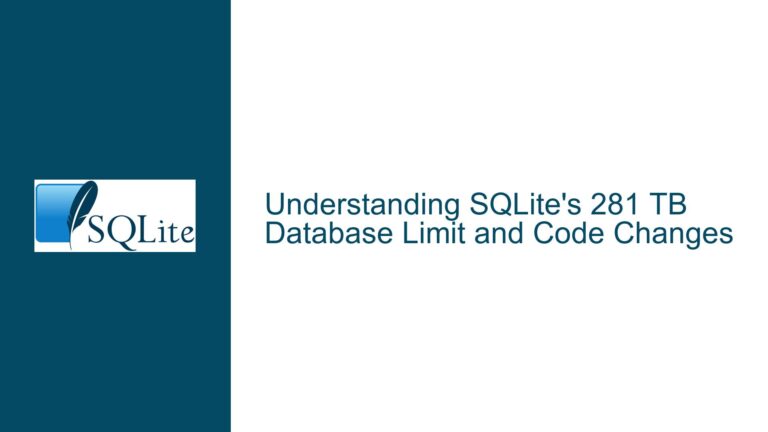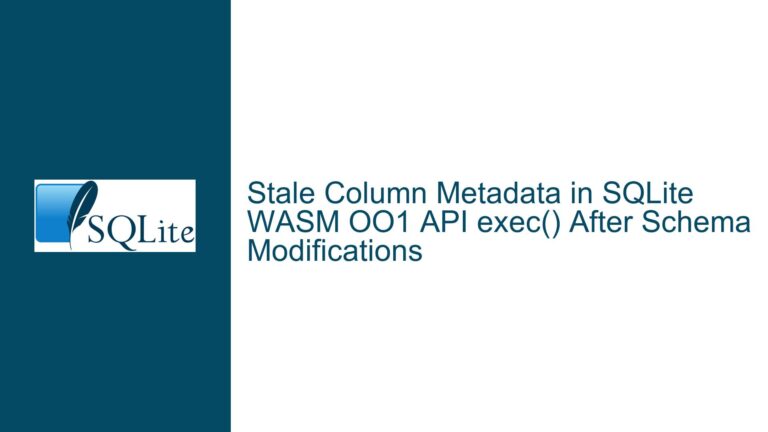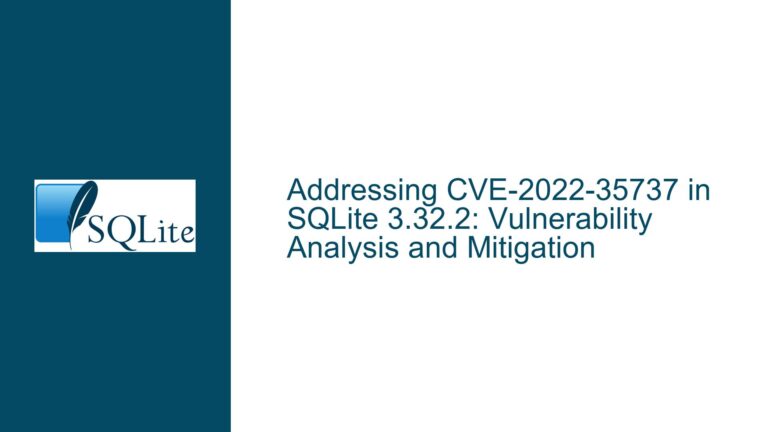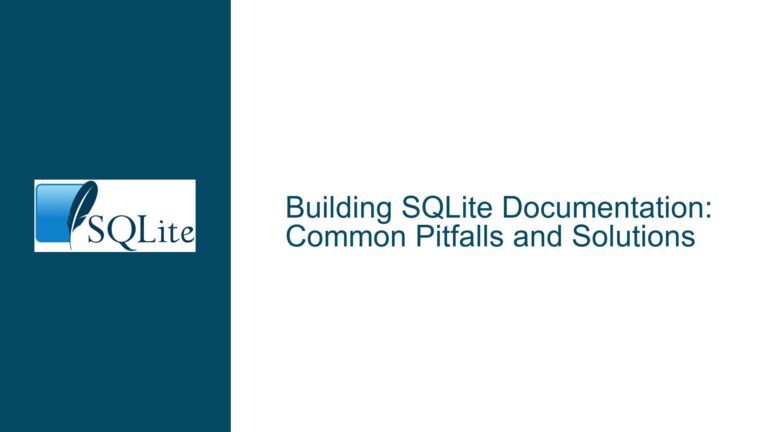Resolving Linker Errors When Building SQLite with SQLITE_OMIT_WAL and SQLITE_MAX_MMAP_SIZE=0
Issue Overview: Undefined Symbols in SQLite Builds with WAL and MMap Disabled
When building SQLite 3.36.0 or newer with the SQLITE_OMIT_WAL and SQLITE_MAX_MMAP_SIZE=0 compilation flags on Unix-like systems (e.g., macOS), the linker fails with an error referencing the missing symbol _unixFcntlExternalReader. This error occurs because the combination of these flags creates an inconsistent configuration where SQLite’s internal code paths expect certain functions and structures to exist, but they are excluded during compilation. The root of the problem lies in the interdependencies between Write-Ahead Logging (WAL) and memory-mapped I/O (mmap) subsystems in SQLite. Disabling WAL mode via SQLITE_OMIT_WAL removes code related to shared memory management, while setting SQLITE_MAX_MMAP_SIZE=0 disables mmap entirely, including structures like unixShmNode. The unixFcntlExternalReader function, which is part of the Unix VFS layer’s file control logic, depends on these excluded components. When unixFileControl (a core file operation handler) attempts to reference unixFcntlExternalReader, the linker cannot resolve the symbol, resulting in a fatal build error.
This issue is particularly relevant for developers aiming to create highly customized SQLite builds, such as in-memory-only configurations or embedded systems with strict resource constraints. The conflict arises from SQLite’s compile-time optimization flags, which are designed to exclude features but may inadvertently create unresolved dependencies between subsystems. Understanding the relationship between WAL, mmap, and the Unix VFS layer is critical to diagnosing and resolving the problem.
Possible Causes: Interdependencies Between WAL, MMap, and VFS Components
1. Incomplete Exclusion of WAL-Related Code Paths
The SQLITE_OMIT_WAL flag disables Write-Ahead Logging, a feature that relies on shared memory segments for coordinating database access between multiple processes. When WAL is omitted, SQLite’s build system removes code related to shared memory management, including the unixShmNode structure and associated functions. However, the Unix VFS layer’s file control operations (e.g., unixFileControl) may still reference WAL-specific functions like unixFcntlExternalReader if those references are not properly guarded by SQLITE_OMIT_WAL preprocessor directives. This creates an inconsistency: the code that defines unixFcntlExternalReader is excluded, but code that uses it remains, leading to linker errors.
2. Conflicting Configuration with SQLITE_MAX_MMAP_SIZE=0
Setting SQLITE_MAX_MMAP_SIZE=0 disables memory-mapped I/O entirely, removing all mmap-related code. This includes the unixShmNode structure, which is part of the shared memory system used by WAL. Even if WAL is disabled, some parts of SQLite’s Unix VFS layer may still interact with mmap-related components. For example, the unixFcntlExternalReader function is designed to work with shared memory locks, which depend on unixShmNode. When both SQLITE_OMIT_WAL and SQLITE_MAX_MMAP_SIZE=0 are set, the system enters a state where essential dependencies for unixFcntlExternalReader are removed, but the function is still referenced elsewhere.
3. Version-Specific Code Organization in SQLite 3.36.0
The error manifests specifically in SQLite 3.36.0 due to changes in how the codebase organizes dependencies between subsystems. Earlier versions of SQLite may not have had the same tight coupling between WAL, mmap, and the Unix VFS layer. In version 3.36.0, the introduction of optimizations or refactoring might have inadvertently created a scenario where unixFcntlExternalReader is conditionally compiled based on flags that conflict with other configuration options. This version-specific behavior explains why developers using older SQLite releases might not encounter the issue.
Troubleshooting Steps, Solutions & Fixes: Reconciling Compilation Flags and Code Dependencies
1. Re-evaluate the Need for SQLITE_OMIT_WAL
Before attempting complex fixes, determine whether SQLITE_OMIT_WAL is truly necessary for your use case. WAL mode is primarily relevant for disk-based databases where concurrent reads and writes are required. If you are using SQLite in an in-memory configuration (e.g., :memory: databases), WAL is automatically disabled, and the SQLITE_OMIT_WAL flag provides no practical benefit. Removing this flag from your build configuration may resolve the linker error without impacting functionality. To verify this, rebuild SQLite with SQLITE_OMIT_WAL removed and test whether WAL-related features are inadvertently enabled. In most in-memory scenarios, they will not be.
2. Adjust SQLITE_MAX_MMAP_SIZE Instead of Disabling It
Setting SQLITE_MAX_MMAP_SIZE=0 is a blunt approach to disabling mmap. Instead, consider setting it to a small positive value (e.g., SQLITE_MAX_MMAP_SIZE=4096) to allow minimal mmap usage without fully enabling it. This ensures that dependencies like unixShmNode remain available to the codebase, even if they are not actively used. If your goal is to minimize memory mapping for security or performance reasons, this compromise allows the build to proceed while keeping mmap usage negligible.
3. Patch the SQLite Source Code to Resolve Symbol Dependencies
If retaining both SQLITE_OMIT_WAL and SQLITE_MAX_MMAP_SIZE=0 is non-negotiable, modify the SQLite source code to remove references to unixFcntlExternalReader when these flags are active. Locate the unixFileControl function in os_unix.c and guard its invocation of unixFcntlExternalReader with preprocessor directives:
#if !defined(SQLITE_OMIT_WAL) && (SQLITE_MAX_MMAP_SIZE>0)
if( op==SQLITE_FCNTL_EXTERNAL_READER ) {
return unixFcntlExternalReader(db, pFile);
}
#endif
This change ensures that the problematic code path is excluded when WAL and mmap are disabled. Rebuild SQLite after applying this patch to verify that the linker error is resolved.
4. Use a Custom SQLite Configuration for In-Memory Databases
For in-memory data processing without disk I/O, leverage SQLite’s built-in support for memory databases and temporary storage. Configure your application to use :memory: databases and set PRAGMA temp_store=MEMORY; to avoid disk operations. This approach eliminates the need for SQLITE_OMIT_WAL or SQLITE_OMIT_DISKIO, as the database engine will naturally avoid WAL and mmap in these scenarios. By relying on runtime configurations instead of compile-time flags, you maintain a simpler build process while achieving the desired behavior.
5. Downgrade to an Older SQLite Version Temporarily
If patching the source code is impractical, consider using SQLite 3.35.5 or earlier, where the dependency between unixFcntlExternalReader and the WAL/mmap subsystems might be less strict. Test the older version with your build flags to confirm that the linker error does not occur. However, this is a short-term workaround; prioritize upgrading to a newer SQLite release once the issue is resolved upstream.
6. Contribute to SQLite’s Compile-Time Flag Documentation
The SQLite documentation does not explicitly warn against combining SQLITE_OMIT_WAL and SQLITE_MAX_MMAP_SIZE=0. If you identify this incompatibility, submit a patch or issue to the SQLite team to update the documentation. This helps future developers avoid similar pitfalls and encourages the community to formalize best practices for custom configurations.
By systematically addressing the interdependencies between WAL, mmap, and the Unix VFS layer, developers can resolve linker errors while maintaining a minimal SQLite build tailored to their specific requirements.






